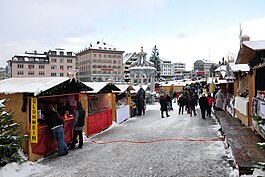Einsiedeln
| Einsiedeln | ||
|---|---|---|
 |
||
|
||
| Coordinates: 47°7′N 8°44′E / 47.117°N 8.733°ECoordinates: 47°7′N 8°44′E / 47.117°N 8.733°E | ||
| Country | Switzerland | |
| Canton | Schwyz | |
| District | Einsiedeln | |
| Area | ||
| • Total | 99.04 km2 (38.24 sq mi) | |
| Elevation | 882 m (2,894 ft) | |
| Population (Dec 2015) | ||
| • Total | 15,077 | |
| • Density | 150/km2 (390/sq mi) | |
| Postal code | 8840 | |
| SFOS number | 1301 | |
| Localities | Bennau, Egg, Euthal, Gross, Trachslau, Willerzell and Biberbrugg (shared with the municipality Feusisberg) | |
| Surrounded by | Alpthal, Altendorf, Feusisberg, Freienbach, Innerthal, Oberägeri (ZG), Oberiberg, Rothenthurm, Unteriberg, Vorderthal | |
| Website |
www SFSO statistics |
|
Einsiedeln (German pronunciation: [ˈainziːdl̩n]) is a municipality and district in the canton of Schwyz in Switzerland known for its monastery, the Benedictine Einsiedeln Abbey. Einsiedeln is also the birthplace of Paracelsus, a Renaissance physician and alchemist who is credited with first naming zinc.
The town is also known as Äinsidle [ˈæɪnˌsɪdlə], in the local Highest Alemannic dialect, and in neighboring dialects as Äisele, Näisele, Äisidle, Näisidle, Äisigle [ˈæɪsələ ˈnæɪsələ ˈæɪˌsɪdlə ˈnæɪˌsɪdlə ˈæɪˌsɪglə]. In the Romansh language it is known as ![]() Nossadunaun .
Nossadunaun .
Archaeologists have discovered numerous artifacts from the stone age and the Bronze Age in the Einsiedeln area. However, it appears from these artifacts, some of which are about 12,000 years old, that the area was thickly wooded and only used by hunters. Until the Early Middle Ages there were no permanent settlements in the area.
...
Wikipedia




